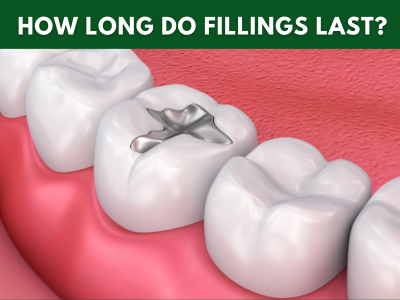How long do fillings last? What every patient should know

When it comes to dental care, one of the most common questions we get asked at our practice is, “How long do fillings last?” As a trusted team of dentists in Hesperia, CA, we understand why patients want to know the longevity of their dental work. Whether you have a new filling or you’ve had one for a while, understanding how long they last and how to take care of them is essential for your overall oral health.
Types of fillings and their lifespan
First, it’s important to know that there are several types of fillings, each with different lifespans. Let’s break down the most common options and how long they typically last:
1. Amalgam fillings
Amalgam fillings, the silver-colored ones, are known for their durability. These fillings can last between 10 to 15 years, and sometimes even longer with proper care. They are highly resistant to wear and tear, which makes them ideal for the back teeth that endure heavy chewing forces. However, over time, they can expand and contract due to temperature changes, which may lead to cracks or leaks.
2. Composite fillings
Composite fillings, which are tooth-colored, are a popular choice for fillings in visible areas. These generally last 5 to 10 years but can wear down more quickly than amalgam fillings. They may need to be replaced sooner if you have heavy biting habits, such as teeth grinding or clenching. Composite fillings bond directly to the tooth, which makes them a more aesthetically pleasing option, but they aren’t as durable as metal-based fillings.
3. Ceramic fillings
Ceramic fillings are made from porcelain and are known for their resistance to staining and their natural appearance. These fillings last 10 to 15 years, making them a great option for both durability and aesthetics. Ceramic fillings are less likely to expand or contract over time, which means they’re less prone to cracking than amalgam fillings. They’re a little more expensive, but they can provide long-term benefits.
4. Resin ionomer fillings
Resin ionomer fillings are often used for fillings in areas that aren’t subjected to heavy chewing. These fillings last around 5 to 7 years and are a good option for people who have cavities in their baby teeth or in non-stress-bearing parts of the mouth. They release fluoride, which can be beneficial for patients who are at a higher risk for cavities.
Factors that affect the longevity of your fillings
How long your filling lasts also depends on several factors. While the material used is important, your habits and oral hygiene also play a significant role in the longevity of your fillings. Here are a few factors to keep in mind:
1. Oral hygiene habits
Proper brushing and flossing are essential for keeping your fillings in good shape. Plaque buildup around a filling can cause decay, which may compromise its integrity and lead to the need for replacement. Make sure to brush twice a day and floss daily to help extend the lifespan of your fillings.
2. Diet and habits
If you have a diet high in sugar or acidic foods, you could be at a higher risk of developing cavities around your fillings. In addition, habits like grinding your teeth or chewing on hard objects (like ice or pens) can wear down fillings more quickly. We recommend avoiding these habits and wearing a nightguard if necessary to protect your fillings and your teeth.
3. Wear and tear
If you frequently chew tough foods, drink acidic beverages, or use your teeth for non-chewing purposes (like opening packages), your fillings may wear down faster. Fillings in areas that undergo constant stress—such as the back teeth—are more likely to degrade over time.
Signs your fillings need to be replaced
Fillings don’t last forever, so it’s essential to watch for signs that indicate it may be time for a replacement. Some of the common signs include:
- Sensitivity :If you start experiencing pain or sensitivity when chewing, drinking, or eating hot or cold foods, this may be a sign that your filling has worn down or cracked.
- Visible cracks: If you notice cracks in your fillings or a change in their color, it could mean that the filling is no longer effectively protecting your tooth.
- Filling falls out: While not common, fillings can sometimes come loose, especially if they were placed many years ago or have undergone a lot of pressure.
- Tooth decay: Cavities that form around the edges of a filling can lead to further decay in the tooth. If left untreated, this could lead to a need for more extensive dental work.
If you notice any of these signs, don’t wait to contact us! We can evaluate your fillings and make sure everything is in good condition.
How to care for your fillings?
Proper care can help prolong the life of your fillings. Here are some tips to maintain your fillings and keep your teeth healthy:
- Brush and floss regularly: Proper oral hygiene is essential to prevent cavities and plaque buildup around your fillings.
- Limit sugary foods and drinks: Avoid frequent consumption of sugary foods, sodas, and acidic drinks, as they can lead to decay.
- Avoid hard foods: Try not to chew on ice, hard candies, or anything that could cause unnecessary stress on your fillings.
- Wear a nightguard: If you grind your teeth at night, wearing a nightguard can prevent damage to both your fillings and your teeth.
Need your fillings checked? Call us today!
If you’re concerned about the condition of your fillings or think it might be time for a replacement, our team at Maple Dental is here to help. We offer comprehensive dental services to ensure that your smile stays healthy and vibrant for years to come.
Ready to book an appointment with our expert dentists in Hesperia, CA? Give us a call at 760-949-7274 or schedule an appointment. Let’s make sure your fillings are in tip-top shape!


